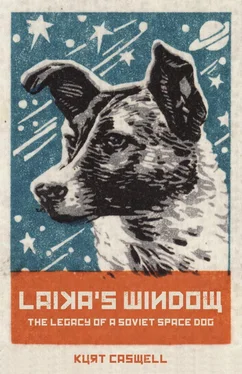After Laika and the space dogs, Ham is probably the most famous animal to fly in space, along with his counterpart Enos. It was Laika’s flight that brought newly formed NASA to Holloman asking to put a chimp into space. If the Soviets could fly a dog into orbit, surely the Americans could fly a chimpanzee. And as our closest relative, the chimpanzee is the perfect test animal to prepare the way for the first human spaceflight. The US still had a chance to put up the first man, and to put up the first man and not kill him you had to test the equipment on an animal you could kill. Holloman already had a chimp colony for research, and the air force began to train some forty chimps for spaceflight. Ham and Enos emerged as the best of the best. They would test the rocket and capsule life-support systems for Project Mercury’s seven astronauts in training, whose story was made famous by Tom Wolfe’s book and the subsequent movie The Right Stuff .
Ham was born in equatorial Africa sometime in July 1957. Captured by animal trappers, he came into possession of the Miami Rare Bird Farm, a kind of breeding facility and tourist attraction (now defunct) from which the air force purchased him for $457. He was a wee chimp when he came to Holloman, weighing in at 19 pounds. Compare that to his flight weight of 37 pounds four years later, then the heaviest animal shot into space, and his gargantuan 175 pounds in retirement, first at the National Zoological Park in Washington, DC, and then at the North Carolina Zoological Park, where in 1983 he died of liver failure and an enlarged heart.
By the late 1950s plenty of animals had been shot into space and brought back alive, proving that living organisms could manage increased radiation and microgravity, at least in the short-term. What NASA did not know was if a man could work in space, and if he could perform the tasks required to operate a spacecraft. In addition to testing the life-support systems of the Mercury capsule, sending a chimp into space would help answer this question.
Ham and Enos were both trained to operate a series of dummy levers inside the Mercury capsule. Strapped into a chair, the chimps sat before a control panel with three lights, each with a corresponding lever. Burgess and Dubbs report that on the far right was a red light that glowed all the time, indicating that the chimp should not press this lever. In the middle was a white light that switched on when the chimp pressed the lever, which he was trained to do every twenty seconds. On the far left, a blue light came on unpredictably during an interval of two minutes, prompting the chimp to press the lever. If the chimp made an error, he was given an electric shock through a metal plate to which his feet were strapped. Because the chimp did not want to get shocked, he did not want to make a mistake. If a chimp could ascend into space on a rocket and return safely to Earth while performing these tasks with the levers, the research team reasoned, then a man could operate a spacecraft on a journey into space.
The chimps were trained by a team led by Master Sergeant Edward Dittmer, an aeromedical technician who began his career in the US Army in 1943 and then transferred to the air force in 1947. In 1955 he came to Holloman. The project was classified, and initially not even Dittmer knew why he was training the chimps. In an interview with George House, then curator at the New Mexico Museum of Space History, Dittmer said, “I never questioned anything because a lot of things at that time were classified and the less you knew of classified, the easier it is to keep it classified.” But it soon became clear to him that the air force planned to use these chimps in rocket research. Dittmer was inducted into the International Space Hall of Fame in 2001 and died at the age of ninety-six in 2015.
As with the Soviet team working with dogs, the care of the chimp colony was of great importance to Colonel Stapp, the ranking officer on the project. “Stapp had chimpanzees for years prior to this—and he was very, very particular with the colony,” Dittmer said. “Anyone that mistreated an animal or anything else, they were out the door. He didn’t put up with any nonsense with his animals.” The veterinary staff too were “all very professional people,” Dittmer said, “and they didn’t want no monkey business as far as the animals.”
Among the staff working on the project, it was Dittmer who was closest to Ham. He had daily contact with Ham, preparing him for his training, guiding him through that training, and overseeing every aspect of his care and well-being. Dittmer’s relationship with Ham (and Enos too) went beyond that of researcher/subject. Ham was a kind of colleague, a chimp with a job to do who relied primarily on Dittmer to help him do it. To do that job, they had to establish a strong working relationship. “I had a very good relationship with Ham, I think,” Dittmer said. “I think—I know he liked me. I’d hold him and he was just like a little kid. He’d put his arm around me and he’d play, you know. He was a well-tempered chimp.”
On January 31, 1961, Dittmer prepared Ham for his flight into space. The team had moved from Alamogordo to Cape Canaveral, Florida, to acclimate weeks ahead of the flight. Training went on as usual. Six chimps were candidates for this first test flight, and Ham was not officially chosen until the day before liftoff. His second was a chimp called Minnie, who would also be prepped alongside him.
Ham would fly on a Mercury-Redstone 2, a liquid oxygen–fueled rocket modified from the Redstone ballistic missile developed by Werner von Braun and his US Army team, the same basic design that put the first US satellite into orbit. Ham would not be flying into orbit, however, but out over the Atlantic where, after reaching an altitude of 115 miles, the capsule would separate from the rocket body, descend on braking chutes, and land in the ocean. Eight navy ships waited in the drop zone to pull the capsule from the water. During the flight, Ham was expected to reach a top speed of 4,400mph and endure about 9g. At 37 pounds, Ham would feel like he weighed 333 pounds.
Dittmer attached electrodes to Ham to monitor his heart during the flight and a respiration sensor. He then helped Ham into his flight suit, strapped him into his capsule seat, attached the shock plates to his feet, and sealed the cover. At 6 a.m. Dittmer accompanied Ham to the rocket. At 7:10 a.m. Dittmer made a final check, looking in at Ham through the window in the cover of his capsule. “It looked like he was smiling at me,” he said in his interview with House.
With Ham ready to fly, the rocket sat on the pad, waiting. Liftoff was scheduled for 9:30 a.m., but twice a team of engineers had to make repairs to bring down the rising temperature in Ham’s capsule. As the team made their way down from the tower the second time, the elevator malfunctioned, and that too had to be repaired. It wasn’t until 11 a.m. that the countdown resumed, and now the weather became a concern, as out over the Atlantic a line of storm clouds was building. It isn’t the wind and rain that pose a danger to a rocket, but rather the possibility of lightning. A lightning strike can damage a rocket’s guidance system and payload, and because rocket fuels are so flammable the whole thing can blow up. The team waited until they got the all clear, and the rocket finally lifted off a few minutes before noon. By this time Ham had been strapped into his capsule for some six hours.
In flight, more problems developed. The engines were burning fuel too fast, resulting in the rocket traveling too fast too soon. Its angle of ascent was sharper and steeper than planned, which meant the recovery teams had to adjust for a new splashdown location. The fuel ran out several seconds early, triggering an abort sequence, which fired and separated the spacecraft from the booster with the force of 17g, a crushing pressure that held Ham’s limbs and head pinned against his seat, pressed back the flesh of his face, and must have made it nearly impossible to breathe. Ham lost focus and abandoned his task at the control panel. The force against him eased up and the electrical plates beneath his feet kicked in, jolting him back to his purpose.
Читать дальше












